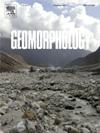Quaternary denudation rates in the eastern Tianshan
IF 3.1
2区 地球科学
Q2 GEOGRAPHY, PHYSICAL
引用次数: 0
Abstract
Predicting how denudation will change in the future, and hence impact the Earth's surface, requires an understanding of the links between past climate variability and denudation responses, especially during the Quaternary. In this study, we reconstructed Quaternary paleo-denudation rates in the eastern Tianshan range (central Asia) and compared the results to climate changes documented by geochemical variations recorded in nearby speleothems. Based on a reanalysis and inversion of 18 published cosmogenic in situ 10Be depth profiles collected across abandoned Quaternary alluvial surfaces, combined with analyses of five new profiles in the northern Tianshan piedmont, we constrained the inherited 10Be paleo-concentrations and when the surfaces were abandoned. To extend the dataset beyond the Mid-Pleistocene Transition, when important changes in denudation are hypothesized to have occurred, we also collected nine ancient river sand samples along the Jingou He section in the northern Tianshan, previously dated by magnetostratigraphy to ∼1.5 to ∼1 Ma. To calculate paleo-denudation rates based on the measured paleo-concentrations, we used both uncorrected cosmogenic paleo-production rates (assuming no ice in the drainage basin) and rates corrected for maximum ice cover extent. Paleo-denudation rates were then normalized to modern values derived from in situ 10Be cosmogenic concentrations previously measured in modern river sand. We observed steady Early Pleistocene denudation rates similar to those at present day in the Jingou He basin. However, since 700 ka during the Middle Pleistocene, paleo-denudation rates were more variable, but uncorrelated with climate oscillations. Those variations may have been due to climatic cooling and a stronger glacial influence that had a nonlinear effect on denudation, yielding spatial variations between drainage basins. However, we see no sustained acceleration in denudation despite the increased amplitude of glacial cycles during the Late Pleistocene.
求助全文
约1分钟内获得全文
求助全文
来源期刊

Geomorphology
地学-地球科学综合
CiteScore
8.00
自引率
10.30%
发文量
309
审稿时长
3.4 months
期刊介绍:
Our journal''s scope includes geomorphic themes of: tectonics and regional structure; glacial processes and landforms; fluvial sequences, Quaternary environmental change and dating; fluvial processes and landforms; mass movement, slopes and periglacial processes; hillslopes and soil erosion; weathering, karst and soils; aeolian processes and landforms, coastal dunes and arid environments; coastal and marine processes, estuaries and lakes; modelling, theoretical and quantitative geomorphology; DEM, GIS and remote sensing methods and applications; hazards, applied and planetary geomorphology; and volcanics.
 求助内容:
求助内容: 应助结果提醒方式:
应助结果提醒方式:


